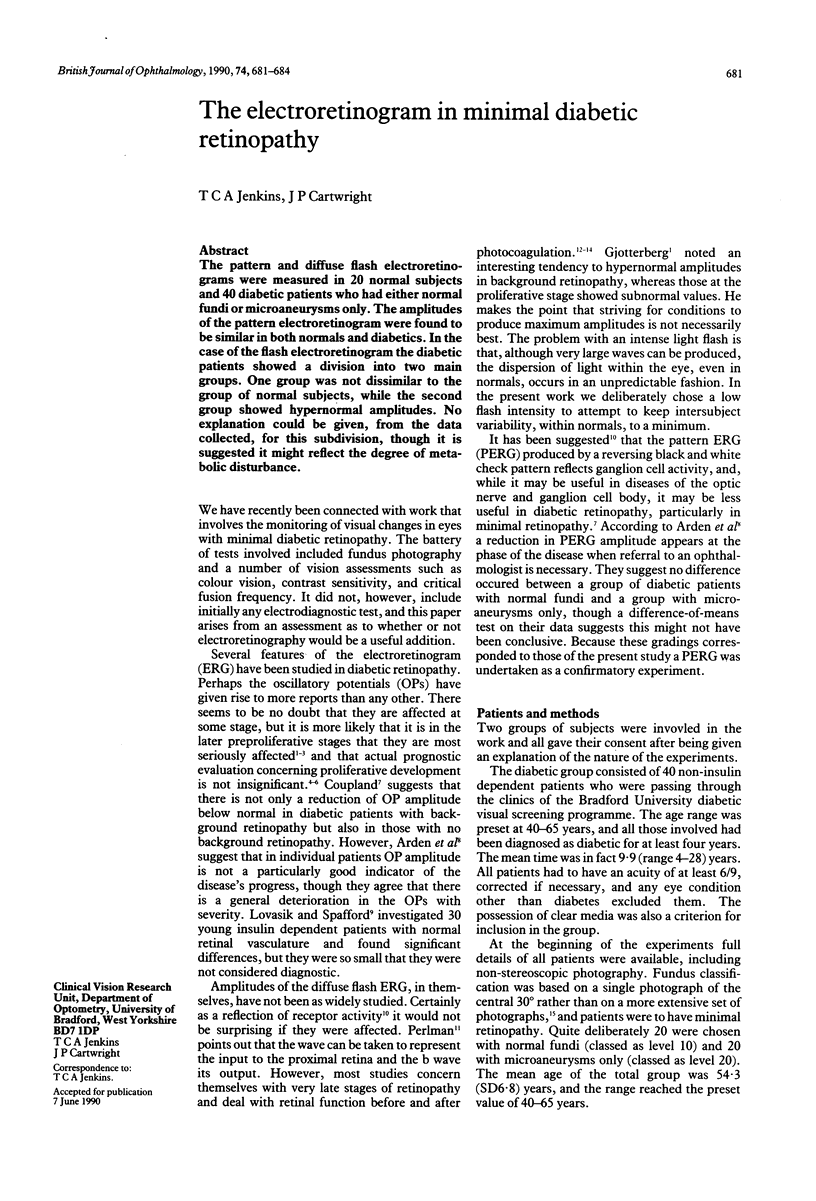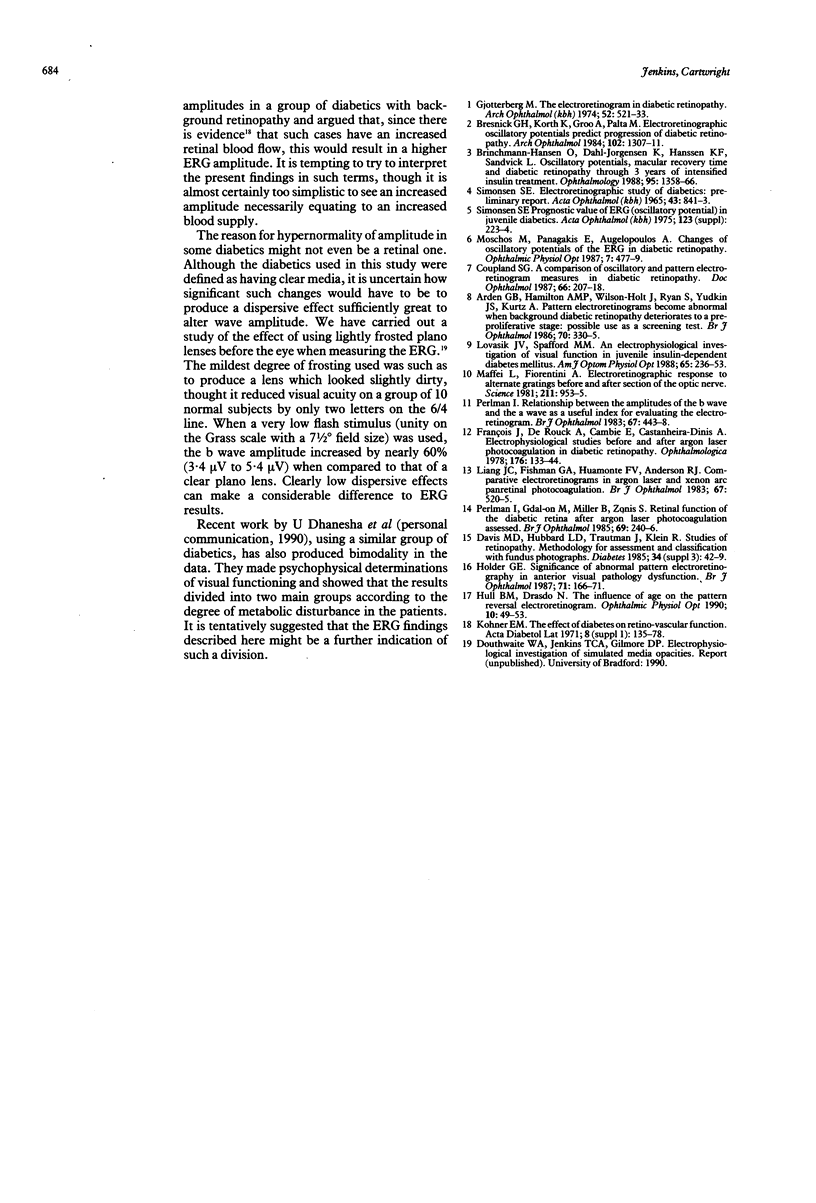Abstract
The pattern and diffuse flash electroretinograms were measured in 20 normal subjects and 40 diabetic patients who had either normal fundi or microaneurysms only. The amplitudes of the pattern electroretinogram were found to be similar in both normals and diabetics. In the case of the flash electroretinogram the diabetic patients showed a division into two main groups. One group was not dissimilar to the group of normal subjects, while the second group showed hypernormal amplitudes. No explanation could be given, from the data collected, for this subdivision, though it is suggested it might reflect the degree of metabolic disturbance.
Full text
PDF



Selected References
These references are in PubMed. This may not be the complete list of references from this article.
- Arden G. B., Hamilton A. M., Wilson-Holt J., Ryan S., Yudkin J. S., Kurtz A. Pattern electroretinograms become abnormal when background diabetic retinopathy deteriorates to a preproliferative stage: possible use as a screening test. Br J Ophthalmol. 1986 May;70(5):330–335. doi: 10.1136/bjo.70.5.330. [DOI] [PMC free article] [PubMed] [Google Scholar]
- Bresnick G. H., Korth K., Groo A., Palta M. Electroretinographic oscillatory potentials predict progression of diabetic retinopathy. Preliminary report. Arch Ophthalmol. 1984 Sep;102(9):1307–1311. doi: 10.1001/archopht.1984.01040031057023. [DOI] [PubMed] [Google Scholar]
- Brinchmann-Hansen O., Dahl-Jørgensen K., Hanssen K. F., Sandvik L. Oscillatory potentials, macular recovery time, and diabetic retinopathy through 3 years of intensified insulin treatment. Ophthalmology. 1988 Oct;95(10):1358–1366. doi: 10.1016/s0161-6420(88)33010-1. [DOI] [PubMed] [Google Scholar]
- Coupland S. G. A comparison of oscillatory potential and pattern electroretinogram measures in diabetic retinopathy. Doc Ophthalmol. 1987 Jun;66(3):207–218. doi: 10.1007/BF00145234. [DOI] [PubMed] [Google Scholar]
- Davis M. D., Hubbard L. D., Trautman J., Klein R. Conference on insulin pump therapy in diabetes. Multicenter study effect on microvascular disease. Studies of retinopathy. Methodology for assessment and classification with fundus photographs. Diabetes. 1985 Aug;34 (Suppl 3):42–49. doi: 10.2337/diab.34.3.s42. [DOI] [PubMed] [Google Scholar]
- François J., De Rouck A., Cambie E., Castanheira-Dinis A. Electrophysiological studies before and after argon-laser photocoagulation in diabetic retinopathy. Ophthalmologica. 1977;176(3):133–144. doi: 10.1159/000308705. [DOI] [PubMed] [Google Scholar]
- Gjötterberg M. The electroretinogram in diabetic retinopathy. A clinical study and a critical survey. Acta Ophthalmol (Copenh) 1974;52(4):521–533. doi: 10.1111/j.1755-3768.1974.tb01763.x. [DOI] [PubMed] [Google Scholar]
- Holder G. E. Significance of abnormal pattern electroretinography in anterior visual pathway dysfunction. Br J Ophthalmol. 1987 Mar;71(3):166–171. doi: 10.1136/bjo.71.3.166. [DOI] [PMC free article] [PubMed] [Google Scholar]
- Hull B. M., Drasdo N. The influence of age on the pattern-reversal electroretinogram. Ophthalmic Physiol Opt. 1990 Jan;10(1):49–53. [PubMed] [Google Scholar]
- Kohner E. M. The effect of diabetes on retino-vascular function. Acta Diabetol Lat. 1971 Sep;8 (Suppl 1):135–178. [PubMed] [Google Scholar]
- Liang J. C., Fishman G. A., Huamonte F. U., Anderson R. J. Comparative electroretinograms in argon laser and xenon arc panretinal photocoagulation. Br J Ophthalmol. 1983 Aug;67(8):520–525. doi: 10.1136/bjo.67.8.520. [DOI] [PMC free article] [PubMed] [Google Scholar]
- Lovasik J. V., Spafford M. M. An electrophysiological investigation of visual function in juvenile insulin-dependent diabetes mellitus. Am J Optom Physiol Opt. 1988 Apr;65(4):236–253. doi: 10.1097/00006324-198804000-00002. [DOI] [PubMed] [Google Scholar]
- Mafei L., Fiorentini A. Electroretinographic responses to alternating gratings before and after section of the optic nerve. Science. 1981 Feb 27;211(4485):953–955. doi: 10.1126/science.7466369. [DOI] [PubMed] [Google Scholar]
- Moschos M., Panagakis E., Angelopoulos A. Changes of oscillatory potentials of the ERG in diabetic retinopathy. Ophthalmic Physiol Opt. 1987;7(4):477–479. [PubMed] [Google Scholar]
- Perlman I., Gdal-On M., Miller B., Zonis S. Retinal function of the diabetic retina after argon laser photocoagulation assessed electroretinographically. Br J Ophthalmol. 1985 Apr;69(4):240–246. doi: 10.1136/bjo.69.4.240. [DOI] [PMC free article] [PubMed] [Google Scholar]
- Perlman I. Relationship between the amplitudes of the b wave and the a wave as a useful index for evaluating the electroretinogram. Br J Ophthalmol. 1983 Jul;67(7):443–448. doi: 10.1136/bjo.67.7.443. [DOI] [PMC free article] [PubMed] [Google Scholar]
- Simonsen S. E. Prognostic value of ERG (oscillatory potential) in juvenile diabetics. Acta Ophthalmol Suppl. 1974;123:223–224. [PubMed] [Google Scholar]


